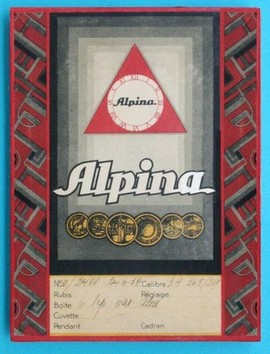

Alpina
Historique de la maison d'horlogerie Alpina
Tout a commencé en 1883, quand Gottlieb Hauser, horloger à Winterthur, établit la Corporation d'Horlogers Suisse. Il s'agit d'une association d'horlogers avec l'objectif d'acquérir des composants horlogers et d'organiser une production de mouvements. En coopération avec des horlogers qualifiés, l'association a commencé petit à petit à développer des calibres tout en élargissant son réseau de distribution. Petit à petit, l'association, propriété de la société Duret & Colonnaz, produisait des ébauches (la base d'un calibre).
En 1890 à Bienne, lieu de production, la production des calibres était maintenant accomplie. Ces actions furent rapidement couronnée de succès. L'association ouvrit des agences non seulement en Allemagne mais aussi en Europe du Nord et de l'ESt. En 1901, le nom "ALPINA" fût enregistré comme marque de fabrique. En même temps, il n'apparu que sur le cadran des montres de haute qualité. Dès le début, les montres ALPINA ne se composait que de pièces de haute qualité, comme des spiraux pour Brequet, des balanciers avec des vis d'or et des boîtiers d'or massif.
en 1909 ALPINA Union Horlogère établissait la "Präcisions-Uhrenfabrik Alpina" à Glashütte.
En 1917, vers la fin de la 1ère guerre mondiale, l'association "Union Horlogère" fut finalement dissoute. Deux sociétés indépendantes furent fondées: L'Union Horlogère SA à Bienne, Suisse, et l'ALPINA Deutsche Uhrmacher Genossenschaft GmbH à Berlin, Allemagne. Une branche qui se trouvait sous la garde des membres suisses constituée comme troisième société indépendante: Alpina Association des Horlogers Suisses.

Images courtesy of Piet Andriessen, Watch-Wiki
Nous soulignerons l'introduction en 1938 de l'Alpina 4. Le numéro '4' pour les 4 principes principales caractéristiques que chaque montre dans la série devait avoir : l'anti-magnétisme, l'étanchéité, l'anti-choc et la production de boitiers en acier inoxydable. L'apparition du quartz bon marché et fabriqué en série au début des années 80 a ébranlé la société. Cependant et contre toute attente, ALPINA s'est accroché durement à ses valeurs et a été revitalisé en 2002.
The story of Alpina starts at the end of the 19th Century when Gottlieb Hauser founded the Swiss Watchmakers Corporation with other independent watchmakers of the region. Initially it was to purchase watch components and to organise the manufacturing but Alpina soon started developing and making our own calibres.

In 1901, the name ‘Alpina’ was registered and appeared for the first time, but only on high end watches. Very soon Alpina was being sold internationally and at our height had nearly 2000 outlets all over the world selling our watches, an exceptional figure for those days. It is no exaggeration to say that Alpina was one of Europe’s leading watchmakers.
Part of the reason for this success, other than the rigorous dedication to design and quality, (values that still hold true today), was the introduction in 1938 of the Alpina 4. The number ‘4’ stood for the 4 core principles that each watch in the series had to have: anti-magnetism, water-resistance, anti-shock and in a stainless steel case.
These principles gave a theme to the watches and can be said to have pointed the way to the development of what was to be the continued success of the company up until the 1970s. It was the so-called ‘Quartz Crisis’ that either sounded the death knell for many companies or meant the creation of major groups.
The emergence of cheap, mass-produced and, above-all, impersonal, watches also nearly meant the end for Alpina. However, despite everything, Alpina hang tough and was revitalized in 2002 and the comeback was on.